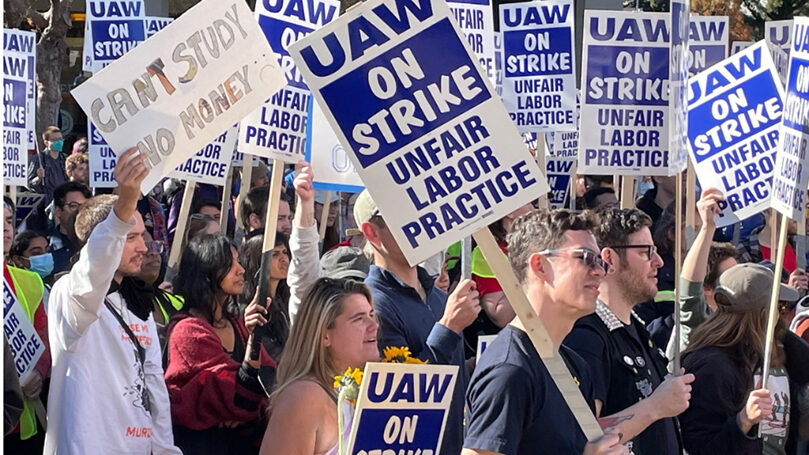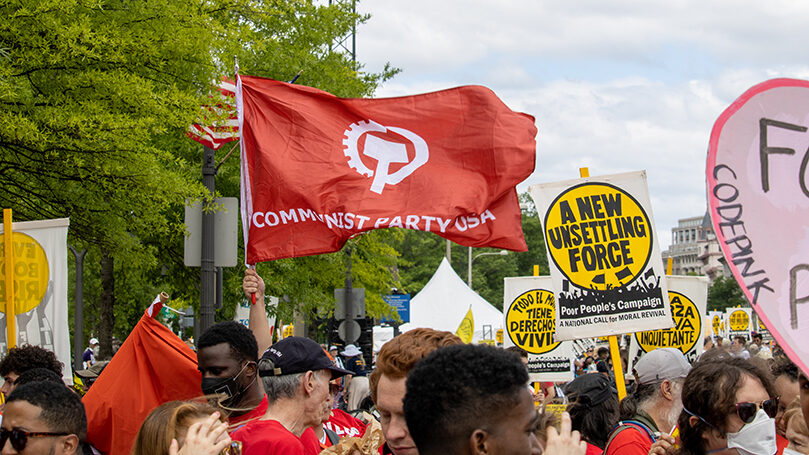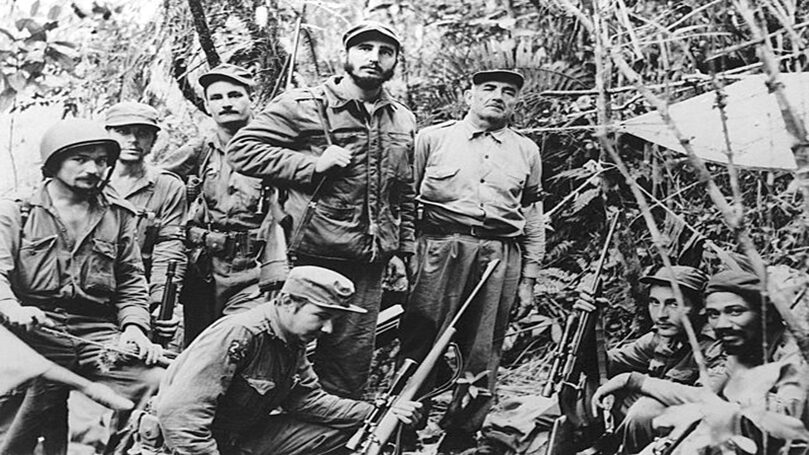
There seems to be some confusion about the terms “vanguard” and “mass organization.”
This is important because both things are necessary to each other, and to our work. I will attempt to clarify the difference between the two organizational forms, and the relationship between them.
“Vanguard” is a military term. In the military context, it means a body of troops which march ahead of the main body. They do not separate themselves from the main body, which would be suicidal, but rather give leadership to it.
As applied to the context of political organizing and struggle, the term “vanguard” refers to those entities which give leadership, or try to, to the greater mass. Lenin and others borrowed this military metaphor to describe what they advocated to be the role of the Bolsheviks in the immense and variegated struggle in Russia in revolutionary times.
To function as the vanguard requires a higher-than-average level of revolutionary political consciousness, and a more coherent and disciplined organizational structure.

Mass organizations are entities that try to be inclusive of all members of a social group. The largest of the mass organizations in capitalist society are typically the labor unions. The strategy of modern labor organizing is to bring everybody in a given workplace and/or industry into the union, regardless of their level of political sophistication. This allows the union to exercise maximum pressure on the employers, and also, for our purposes, teaches workers important lessons of class unity. In other words, in the best situations, the union builds class consciousness, which is essential but is not the same as revolutionary consciousness. Class consciousness means the awareness of the members of the working class that they are workers, that as such they are in an antagonistic relationship not just with their individual employers, but also with the ruling class as a whole, and that as workers they are “all in the same boat together”—and must stick together in solidarity. Revolutionary consciousness, on the other hand, means awareness of the necessity of overthrowing the capitalist system, of expropriating the expropriators and of building a new society—socialism. But revolutionary consciousness can’t be built if there is no class consciousness. Class consciousness and class struggle together constitute the fertile soil in which the seeds of revolutionary consciousness are planted.
Although one could say that vanguard organizing is superior to mass organizing, it is important to realize that there is not an antagonistic relationship between the two things.
In other words, the vanguard is only effective insofar as it articulates with the mass and develops the best and most positive relationship possible with the mass organizations. Though the level of revolutionary consciousness of the members of the vanguard is naturally higher, on the average, than that of the masses, this does not imply an antagonistic relationship between the two. Indeed, they are a dialectical unity. And vanguards are made by active contributions to the class struggle, not simply declared from on high.
This fact is sometimes forgotten or misunderstood by some on the left who do not have experience working with the masses. They talk as if the vanguard is something that rejects the mass; in fact the vanguard has no importance except as it relates to the mass. Socialism is not attained by relatively small vanguard groups; it is the project of the working class. The class consciousness necessary for bringing the working class (and close allies) to revolutionary consciousness is achieved through mass organizing (in workplace and working-class communities) and political education/study. The revolutionary consciousness necessary to point the class struggle in a revolutionary, socialist direction is achieved within the context of class struggle and class consciousness, but goes beyond these two things. It requires revolutionary theory and an activist, highly focused, and self-sacrificing democratic leadership to play the vanguard role. In our party, we call this the communist plus.

What does this imply for the specific way we communists work? Two things:
First, to achieve revolutionary changes you need a specific organization designed and dedicated to bringing about those changes. This must be an organization that is independent, theoretically well grounded, and extremely dedicated to the revolutionary goal. That is the Communist Party—the vanguard. This is the main message of Lenin’s first major book, What Is to Be Done?
Second, the vanguard, or communist party, cannot play its role outside the context of the struggles of the working class and exploited masses. To borrow another military term, we must be embedded in the struggles of the working class and toiling masses, and not separate ourselves from them. This, in turn, is the major message of another book by Lenin, Left Wing Communism: An Infantile Disorder. One of Lenin’s main points in that book is that communists have to be present where the working class actually is, and not either stand aloof from the working class because it is not yet revolutionary, or busy ourselves with creating tiny alternative pseudo working-class entities that have, because of their small size and sectarian attitudes, absolutely no chance of leading the workers or influencing events in the real world.
Yet over the 175 years that have passed since the Communist Manifesto, and the 102 years since Lenin published Left Wing Communism, the same basic confusion has continued to pop up among the left, including in the United States.
This attitude leads to serious mistakes.
One mistake is left sectarianism, or the idea that since my small group has decided it is the vanguard, it must, in its practical work, take a hostile and exclusionary attitude toward anybody it disagrees with, often on some ultra-fine doctrinal point. This shuts it off from any serious ability to play a constructive and helpful role in the mass organizations and their struggles. And a “vanguard” which does not have a good working relationship with the broad masses is not a vanguard; it is a sect or cult.
Another mistake is ultra-leftism, the idea since my small group is the true vanguard, its more advanced ideas should involve taking the struggle “to another level” beyond what the working class and masses are ready to adopt at a given moment.
This in turn can lead to two even more dangerous things:
Left opportunism, meaning the unprincipled wielding of extreme left slogans and tactics to outflank mass forces and struggles. This creates hostility between the left and the masses—exactly the opposite of what we’re trying to do, which is to build trust. Trust of the working class and masses for the vanguard is destroyed if the impression is made that the latter is simply imposing itself on the people’s struggles for its own narrow ends, instead of helping to build those struggles.
Adventurism, meaning trying to move from peaceful methods of struggle to extreme methods, including armed struggle, for no other reason that the adventurists think the latter is automatically more revolutionary. This can create a severe breach between the self-defined vanguard and the masses, discourage mass participation in open struggle (because of the real or perceived dangers of such participation), and open the door to the activities of police repression and agents provocateurs. In fact, that which is revolutionary is that which most advances the working-class struggle, not necessarily that which is loudest and most daring.
Does age have anything to do with these errors, as we sometimes hear? Let’s remember that when Marx and Engels wrote the Communist Manifesto, Marx was 30 and Engels 28. When Lenin wrote What Is to Be Done, he was 32. When Fidel’s forces besieged the Moncada Barracks, he was 27. And when revolutionary forces, 64 years ago this January 1, marched into Havana to a rapturous welcome, the comrade who led them, Ernesto “Che” Guevara, was 31. Yes, experience and study are important if we want to avoid errors, but youth can contribute mightily also, as it always has—and always will.

One final note: Praxis makes perfect . . .
In our country, the urgent priority is to strengthen the position of the working class in the class struggle. This impels us to many tactical imperatives: To fight for the rights of the working class and masses, to combat racism, sexism, homophobia-transphobia, anti-immigrant oppression and bias, national chauvinism, anticommunism, and anything else that tends to divide and weaken the working class and its allies and thus help the ruling class.
How do we know if we are contributing to the strengthening of the working class? We can only know it when we participate in its struggles full blast.
So in this new year of 2023, let’s get out there and do that participating.
Images: Uber drivers stage a one-day strike in NYC, Adrian Childress, photo cropped, NY Taxi Workers Alliance (Facebook); University of California, Berkeley, graduate student workers on strike, Marilyn Bechtel, People’s World; CPUSA at the Poor People’s March, 6-18-22, Erik Shilling; A young Fidel Castro and comrades in the Sierra Maestra, 1956, Wikipedia (public domain).


 Join Now
Join Now